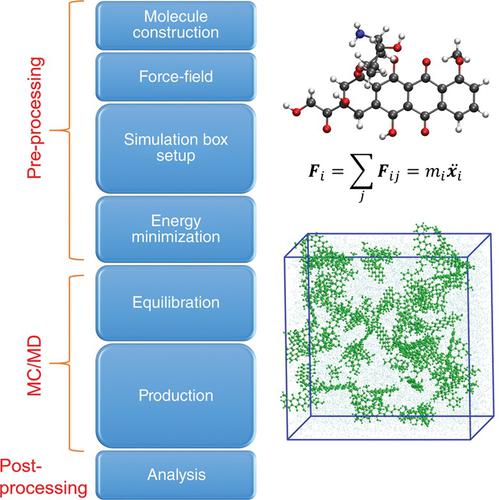当前位置:
X-MOL 学术
›
WIREs Comput. Mol. Sci.
›
论文详情
Our official English website, www.x-mol.net, welcomes your
feedback! (Note: you will need to create a separate account there.)
Molecular simulations in drug delivery: Opportunities and challenges
Wiley Interdisciplinary Reviews: Computational Molecular Science ( IF 16.8 ) Pub Date : 2018-02-01 , DOI: 10.1002/wcms.1358 Ratna S. Katiyar 1 , Prateek K. Jha 1
Wiley Interdisciplinary Reviews: Computational Molecular Science ( IF 16.8 ) Pub Date : 2018-02-01 , DOI: 10.1002/wcms.1358 Ratna S. Katiyar 1 , Prateek K. Jha 1
Affiliation

|
Molecular simulations are promising tools for in silico design of drug delivery formulations, as they provide a prediction of formulation properties prior to synthesis thus minimizing the need for in vitro and in vivo experimentation. The detailed molecular insight obtained by these simulations is precious and often beyond the reach of sophisticated experimental facilities. Although initially limited to the prediction of single‐molecule behavior (e.g., drug orientation in a bilayer), gradual advances in computing speed and efficient simulation approaches have made it feasible to employ these methods for phenomena occurring at substantially large length and time scales (e.g., carrier‐drug complexation) with modest computational cost and resources. We present a nonmathematical review of molecular simulation methods and their applications in drug delivery, with special emphasis on the use of atomistic and coarse‐grained Monte Carlo (MC) and molecular dynamics (MD) methods and excluding the drug docking studies used in drug discovery. Current capabilities and problems associated with the use of these methods in the context of drug delivery are highlighted, along with a discussion of representative applications of molecular simulations in drug delivery. We conclude that while molecular simulations are expected to play a central role in the future of drug delivery field, we require a concerted effort of computational scientists, experimentalists, and industry personnel working on drug delivery to identify specific areas where these simulations can be especially useful.
中文翻译:

药物输送中的分子模拟:机遇与挑战
分子模拟是药物递送制剂计算机设计的有前途的工具,因为它们可以在合成之前预测制剂的性质,从而最大限度地减少了体外和体内实验的需要。通过这些模拟获得的详尽的分子洞察力是宝贵的,并且往往超出了精密实验设备的能力范围。尽管起初仅限于预测单分子行为(例如,双层药物的取向),但是计算速度的逐步提高和有效的模拟方法使将这些方法用于在相当大的长度和时间范围内发生的现象(例如, ,载体与药物的复杂性)和适度的计算成本和资源。我们对分子模拟方法及其在药物输送中的应用进行了非数学的综述,特别强调了原子和粗粒度蒙特卡洛(MC)和分子动力学(MD)方法的使用,并且不包括用于药物发现的药物对接研究。着重介绍了与在药物输送中使用这些方法相关的当前功能和问题,并讨论了分子模拟在药物输送中的代表性应用。我们得出的结论是,虽然分子模拟有望在药物输送领域的未来中发挥中心作用,但我们需要从事药物输送的计算科学家,实验学家和行业人员的共同努力,以找出在这些模拟中特别有用的特定领域。特别强调使用原子和粗粒度蒙特卡罗(MC)和分子动力学(MD)方法,并且不包括用于药物发现的药物对接研究。着重介绍了与在药物输送中使用这些方法相关的当前功能和问题,并讨论了分子模拟在药物输送中的代表性应用。我们得出的结论是,虽然分子模拟有望在药物输送领域的未来中发挥中心作用,但我们需要从事药物输送的计算科学家,实验学家和行业人员的共同努力,以找出在这些模拟中特别有用的特定领域。特别强调使用原子和粗粒度蒙特卡罗(MC)和分子动力学(MD)方法,并且不包括用于药物发现的药物对接研究。着重介绍了与在药物输送中使用这些方法相关的当前功能和问题,并讨论了分子模拟在药物输送中的代表性应用。我们得出的结论是,虽然分子模拟有望在药物输送领域的未来中发挥中心作用,但我们需要从事药物输送的计算科学家,实验学家和行业人员的共同努力,以找出在这些模拟中特别有用的特定领域。
更新日期:2018-02-01
中文翻译:

药物输送中的分子模拟:机遇与挑战
分子模拟是药物递送制剂计算机设计的有前途的工具,因为它们可以在合成之前预测制剂的性质,从而最大限度地减少了体外和体内实验的需要。通过这些模拟获得的详尽的分子洞察力是宝贵的,并且往往超出了精密实验设备的能力范围。尽管起初仅限于预测单分子行为(例如,双层药物的取向),但是计算速度的逐步提高和有效的模拟方法使将这些方法用于在相当大的长度和时间范围内发生的现象(例如, ,载体与药物的复杂性)和适度的计算成本和资源。我们对分子模拟方法及其在药物输送中的应用进行了非数学的综述,特别强调了原子和粗粒度蒙特卡洛(MC)和分子动力学(MD)方法的使用,并且不包括用于药物发现的药物对接研究。着重介绍了与在药物输送中使用这些方法相关的当前功能和问题,并讨论了分子模拟在药物输送中的代表性应用。我们得出的结论是,虽然分子模拟有望在药物输送领域的未来中发挥中心作用,但我们需要从事药物输送的计算科学家,实验学家和行业人员的共同努力,以找出在这些模拟中特别有用的特定领域。特别强调使用原子和粗粒度蒙特卡罗(MC)和分子动力学(MD)方法,并且不包括用于药物发现的药物对接研究。着重介绍了与在药物输送中使用这些方法相关的当前功能和问题,并讨论了分子模拟在药物输送中的代表性应用。我们得出的结论是,虽然分子模拟有望在药物输送领域的未来中发挥中心作用,但我们需要从事药物输送的计算科学家,实验学家和行业人员的共同努力,以找出在这些模拟中特别有用的特定领域。特别强调使用原子和粗粒度蒙特卡罗(MC)和分子动力学(MD)方法,并且不包括用于药物发现的药物对接研究。着重介绍了与在药物输送中使用这些方法相关的当前功能和问题,并讨论了分子模拟在药物输送中的代表性应用。我们得出的结论是,虽然分子模拟有望在药物输送领域的未来中发挥中心作用,但我们需要从事药物输送的计算科学家,实验学家和行业人员的共同努力,以找出在这些模拟中特别有用的特定领域。











































 京公网安备 11010802027423号
京公网安备 11010802027423号